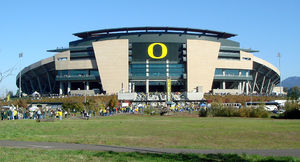Autzen Stadium

Looking north in October 2007
|
|
| Location | 2727 Leo Harris Parkway Eugene, Oregon, U.S. |
|---|---|
| Coordinates | 44°3′30″N 123°4′7″W / 44.05833°N 123.06861°WCoordinates: 44°3′30″N 123°4′7″W / 44.05833°N 123.06861°W |
| Owner | University of Oregon |
| Operator | University of Oregon |
| Capacity | 54,000, standing room to 60,000(2002–present) 41,698 (1988–2001) 41,097 (1969–1986) 41,078 (1967–1968) |
| Surface |
FieldTurf – (2002–present) NeXturf – (2001) OmniTurf – (1984–2000) AstroTurf – (1969–1983) Natural grass – (1967–1968) |
| Construction | |
| Broke ground | 1966 |
| Opened | September 23, 1967 |
| Renovated | 2002 |
| Expanded | 2002 |
| Construction cost | US$2.3 million $80 million (2002 renovation) |
| Architect |
Skidmore, Owings & Merrill Ellerbe Becket (2002 renovation) |
| General contractor | Gale M. Roberts Co. (1967) |
| Tenants | |
|
University of Oregon Ducks – (NCAA) (1967–present) |
|
Autzen Stadium is an outdoor football stadium in the northwest United States, in Eugene, Oregon. Located north of the University of Oregon campus, it is the home field of the Oregon Ducks of the Pac-12 Conference. Opened 50 years ago in 1967, the stadium has undergone several expansions. The official capacity is 54,000.
Prior to 1967, the Ducks' on-campus stadium was Hayward Field, which they shared with the track and field team. However, by the 1960s, it had become apparent that the 22,500-seat stadium was no longer suitable for the football team. The Ducks only played three home games per year on campus in most years; with the exception of the Civil War, the annual rivalry game with Oregon State, games that were likely to draw big crowds (against schools like Washington and USC) were played 110 miles (180 km) north in Portland at the larger Multnomah Stadium. With the recognition that the football team had outgrown the campus facility and with popular support to play the entire home schedule in Eugene, Oregon athletic director Leo Harris led a campaign to build a new stadium on 90 acres (0.36 km2) that the school had acquired for the purpose in the 1950s on his recommendation.
The stadium, designed by Skidmore, Owings & Merrill, was built within an artificial landfill (over the refuse) to eliminate the need for multilevel ramps. As a result, construction took just nine months and cost approximately $2.3 million. Two hundred and fifty thousand dollars was contributed by the Autzen Foundation, headed by Thomas E. Autzen, son of Portland lumberman and philanthropist Thomas J. Autzen (1888–1958), for whom the stadium was named. Ironically, Autzen was an alumnus of archrival Oregon State University. The foundation's donation was linked to his son, a UO alumnus from the class of 1943.
...
Wikipedia
